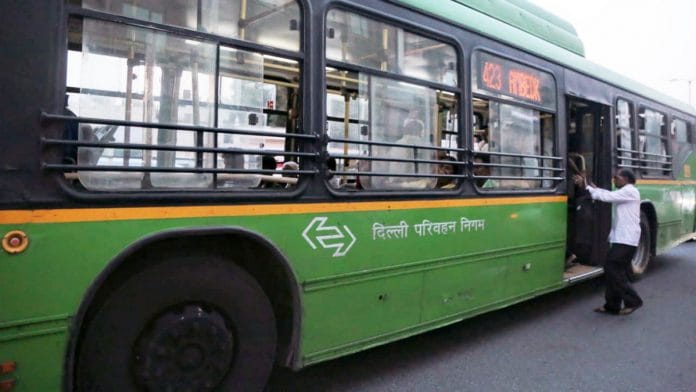New Delhi: From financial year 2011-12 to 2021-22, the Delhi Transport Corporation (DTC) inducted only two buses in the national capital where lakhs of commuters depend on the public transporter, according to the Comptroller and Auditor General (CAG).
The Corporation then went on to add another 298 buses in the period between March and November 2022, the CAG said in the performance audit on ‘Functioning of Delhi Transport Corporation’ covering the period 2015-16 to 2021-22.
Correspondingly, the bus fleet shrank from 4,344 (2015-16) to 3,937 buses (2022-23).
“Audit observed that Rs 236.82 crore was available for procurement of buses in 2015 and Rs 233.06 crore was available for this purpose as of March 2022. The Corporation failed to induct new buses (except two Electric Buses in March 2022 and 298 buses after March 2022 up to November 2022) into its fleet during the last 10 years (last bus was inducted in 2011-12),” the report said.
This depletion, according to the report tabled Monday in the Delhi Assembly, happened despite availability of funds for procuring buses.
The Delhi High Court in September 2007 had directed the Delhi government to increase the city bus fleet to 11,000 buses by the end of March 2009, the report said. The Delhi government then decided to come up with a new scheme under which DTC and Delhi Integrated Multi-Modal Transit System (DIMTS), which operates the cluster buses, were to operate 5,500 buses each.
Instead, the CAG found that 7,001 buses (3,762 DTC buses and 3,239 DIMTS buses) were available in Delhi as on 31 March, 2022.
The CAG recommended that the DTC needs to “expedite availability of the prescribed number of road-worthy buses” for operations with the AMC (Annual Maintenance Contract) contractors.
The report, which was not tabled by the Aam Aadmi Party (AAP) during its tenure, highlighted lack of planning, poor financial management, and delay in increasing fares among others that led to financial losses. The DTC’s financial liability rose from Rs 28,263 crore in FY16 to Rs 65,274.3 crore in FY22, it said.
The AAP had first formed the government in Delhi with the help of the Congress in December 2013, but it was for a brief period of 49 days. It then came to power on its own in 2015 and won again in 2020. The party, however, lost power in the polls held in February this year.
In January 2022, then chief minister Arvind Kejriwal had flagged off DTC’s first electric bus at Indraprastha’s depot. Between 2021 and 2023, the CAG found, DTC procured only 300 e-buses.
Ageing buses, delay in procurement
The DTC had “merely a fleet of 3,937 buses”, which included 1,770 overage buses, by 31 March 2023, the report mentioned. The low-floor CNG buses were being operated by DTC beyond the prescribed “12 years useful life”.
“The number of overage low floor buses in the Corporation fleet during 2018-23 increased from 0.13 percent (five buses in 2018-19) to 44.96 per cent (1,770 buses in 2022-23),” it said, attributing this to delay in procurement of new buses.
The DTC Board approved nine proposals for procurement of buses during the period 2013 to 2021. “However, these could not progress to Tendering stage either due to non-receipt of formal approval from Government of National Capital Territory of Delhi (GNCTD) or change in specifications by GNCTD,” the report said.
The CAG also pointed out that the Corporation’s inordinate delay in finalising the bids for procurement of electric buses under the Centre’s Fast Adoption and Manufacturing of Electric Vehicles (FAME) I and II schemes.
“The Corporation lost the opportunity of availing Central assistance of ₹ 49 crore under FAME-I Scheme due to lack of clarity about specification of buses and indecision,” the report said. “Delay in finalisation of bids for 300 electric buses under FAME-II Scheme led to delay in procurement of buses with consequent reduction of contract period from 12 years to 10 years….”
Operational efficiency impacted
The ageing fleet adversely impacted DTC’s operational efficiency. While the contractors were expected to ensure 92 percent availability of buses on roads, the DTC fleet utilisation was 85.27 percent in 2021-22.
The fleet utilisation, according to the audit watchdog, was impacted primarily for frequent breakdowns largely due to overage buses. “Breakdowns ranged between 2.90 and 4.57 per 10,000 km of operations which was too high as compared to other State Transport Undertakings (STUs) and Cluster Buses (by DIMTS),” it said.
In contrast, the fleet utilisation of cluster buses was 99.01 percent in 2021-22. “Cluster Buses performance was much better than that of the Corporation in almost every Operational Parameter even though both were performing in similar circumstances,” the report said.
Accumulated losses up by Rs 35,000 crore
“The financial health had deteriorated over the period (2015-16 to 2021-22). The Corporation incurred huge operational and manpower expenditure which was not commensurate with the revenue earned resulting in accumulation of losses, low solvency ratio and negative net worth. The operating revenue collection had a decreasing trend due to non-revision of fare and lower commuter base,” it said.
The auditor highlighted the lack of both short- and long-term plans for bus routes, scheduled trips, and annual operational targets.
“However, it has prepared neither any Business Plan containing a formal statement of its goals and determining targets of operational and financial parameters to achieve the goals, nor a perspective plan…In the absence of proper planning, the efforts of the Corporation for achieving its mandated objectives were directionless and uncoordinated,” the CAG report said.
(Edited by Tony Rai)
Also Read: You know India’s GDP but do you know your city’s? Govt takes key step to boost growth of cities






